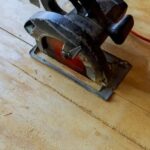Are you wondering how to remove paint from woodwork? Removing old paint from woodwork can be a challenging and time-consuming task, but with the right knowledge and tools, it can be done effectively. Whether you are looking to refinish your woodwork or prepare it for a fresh coat of paint, understanding the best methods for removing paint is essential.
When it comes to removing paint from woodwork, there are various factors to consider, such as the type of paint used and how it adheres to the wood surface. In this article, we will explore the different types of paint and their adhesion properties, as well as provide a step-by-step guide to using chemical strippers for paint removal.
In addition to chemical strippers, we will also explore alternative methods for removing paint from woodwork, including the use of heat guns and sanding. We will discuss precautions and safety measures that should be taken during the paint removal process, as well as tips for choosing the right tools and equipment for the job.
Lastly, we will cover how to properly prepare the woodwork for repainting or refinishing, troubleshoot common problems that may arise during the paint removal process, and recap best practices for achieving optimal results.
Understanding the Different Types of Paint and How They Adhere to Wood
When it comes to removing paint from woodwork, it’s crucial to understand the different types of paint and how they adhere to wood. This knowledge will help you choose the most effective method for paint removal, whether you’re dealing with latex paint, oil-based paint, enamel, or other types of finishes.
Latex paint is a popular choice for woodwork due to its fast drying time and easy cleanup with soap and water. However, it can be quite stubborn to remove once it has cured. On the other hand, oil-based paint creates a durable finish that adheres well to wood but requires harsher chemicals for removal.
Enamel paints are known for their glossy finish and are often used on trim and cabinets. Understanding the specific properties of each type of paint will guide you in selecting the right approach for removal.
Chemical strippers are commonly used for removing multiple layers of paint from woodwork. They work by softening the bond between the paint and the wood surface, making it easier to scrape or wash away the old finish.
However, this method requires careful application and adequate ventilation due to the toxic nature of some chemical strippers. Heat guns can also be used to soften and lift paint from woodwork, while sanding is a more labor-intensive but effective approach for small areas or stubborn spots of old paint.
Lastly, it’s important to consider safety precautions when removing paint from woodwork. Ventilation is key when working with chemical strippers or heat guns to avoid inhaling harmful fumes. Protective equipment such as gloves, goggles, and respirators should also be used to minimize exposure to potentially hazardous substances during the removal process.
| Types of Paint | Adhesion Properties |
|---|---|
| Latex Paint | Fast drying time, easy cleanup with soap and water, stubborn when cured |
| Oil-Based Paint | Durable finish, requires harsher chemicals for removal |
| Enamel Paint | Glossy finish, adheres well but challenging for removal |
Step-by-Step Guide to Removing Paint Using Chemical Strippers
Chemical strippers can be a highly effective method for removing paint from woodwork, but it’s important to follow the proper steps to ensure success and safety. Before beginning the process, it’s crucial to gather all the necessary supplies, including chemical stripper, gloves, protective eyewear, and adequate ventilation.
The first step is to apply a generous amount of the chemical stripper onto the painted surface using a brush or roller. It’s important to work in manageable sections to prevent the stripper from drying out before it has a chance to loosen the paint.
After applying the chemical stripper, allow it to sit on the woodwork for the recommended amount of time as stated in the product’s instructions. This allows the stripper to penetrate and soften the layers of paint. Once enough time has passed, use a putty knife or scraper to gently remove the softened paint from the woodwork. It’s essential to take care during this step to avoid damaging the underlying wood surface.
After removing as much paint as possible with the scraper, use steel wool or a scrubbing brush along with mineral spirits or water to clean off any remaining residue. This will help prepare the wood for refinishing or repainting.
Finally, thoroughly rinse and dry the woodwork before moving on to any further steps in your refinishing process. By carefully following these steps and exercising caution throughout, you can successfully remove paint from woodwork using chemical strippers while safeguarding yourself and your surroundings from harm.
Exploring Alternative Methods for Removing Paint, Such as Heat Guns and Sanding
When it comes to removing paint from woodwork, chemical strippers may not always be the most suitable option. In such cases, alternative methods like using heat guns and sanding can be considered. These methods can be particularly effective for smaller areas or intricate details where chemical strippers may be difficult to apply or remove.
Heat guns are a popular choice for removing paint from woodwork, especially in cases where the paint is thick or stubborn. By directing heat onto the painted surface, the paint softens and bubbles up, making it easier to scrape off with a putty knife or scraper. It is important to note that heat guns can reach high temperatures, so caution should be taken to avoid scorching or damaging the woodwork.
Sanding is another method that can be used to remove paint from woodwork, especially when dealing with thin layers of paint or when a smoother finish is desired. Sanding can be done manually with sandpaper or with the help of power sanders for larger areas. This method may take more time and effort compared to using chemical strippers or heat guns, but it provides precise control over the removal process and allows for smooth and even results.
| Method | Advantages |
|---|---|
| Heat Guns | Effective for thick or stubborn paint |
| Sanding | Precise control over removal process; Smooth finish |
Precautions and Safety Measures to Take When Removing Paint From Woodwork
When it comes to removing paint from woodwork, it’s important to prioritize safety and take the necessary precautions. Paint removal can involve working with chemicals and tools that can pose risks if not handled properly. By following the right safety measures, you can ensure a smooth and secure paint removal process.
Protective Gear
Before starting the paint removal process, it’s crucial to wear the appropriate protective gear. This includes gloves to protect your hands from chemicals, goggles to shield your eyes from splatters or fumes, and a respirator mask to prevent inhalation of any harmful fumes or particles. Additionally, wearing long sleeves and pants can help protect your skin from exposure to chemical strippers or other paint removal methods.
Ventilation
Proper ventilation is essential when removing paint from woodwork, especially when using chemical strippers. This helps dissipate any fumes produced during the process and prevents them from accumulating in an enclosed space. Open windows and use fans to create airflow in the area where you are working. If working indoors, consider using a portable air purifier or exhaust fan to ensure good air quality.
Safe Disposal of Waste
After removing the paint, you will be left with waste materials such as used chemical strippers, sanding dust, or scraped off paint residue. It’s important to handle and dispose of these materials safely. Follow local regulations for hazardous waste disposal and never pour excess chemicals down drains or dispose of them in regular trash bins. Instead, look for designated collection facilities in your area that accept hazardous waste for proper disposal.
By taking these precautions and safety measures when removing paint from woodwork, you can minimize potential risks and ensure a safer work environment for yourself and those around you. Always prioritize safety throughout the paint removal process to achieve successful results without compromising well-being.
Tips for Choosing the Right Tools and Equipment for the Job
When it comes to removing paint from woodwork, choosing the right tools and equipment can make a significant difference in the success of your project. The type of paint, condition of the wood, and your level of expertise will all play a role in determining which tools and equipment are best suited for the job.
Consider the Type of Paint and Wood
Before deciding on which tools to use, consider the type of paint that needs to be removed. Different types of paint may require different removal methods and tools. For example, latex paint may respond well to certain chemical strippers, while oil-based paint may require a heat gun or sanding. Additionally, consider the type and condition of the woodwork itself. Delicate or antique woodwork may require more gentle removal methods to avoid causing damage.
Choosing the Right Tools
Chemical strippers can be effective at removing multiple layers of paint without damaging the wood underneath. Look for a high-quality chemical stripper that is designed specifically for use on wood surfaces. Heat guns are also effective for removing paint from woodwork, as they can soften the paint for easy scraping. When using a heat gun, it’s important to choose one with adjustable temperature settings to prevent scorching or damaging the wood.
Selecting Safety Equipment
Regardless of which method you choose, safety should always be a top priority when removing paint from woodwork. When using chemical strippers or sanding, be sure to wear protective gloves, goggles, and a mask to protect yourself from fumes and dust. When using a heat gun, proper ventilation is essential to ensure that harmful fumes are not inhaled. Always follow safety guidelines provided by manufacturers when using any type of paint removal tool or equipment.
By considering these factors and selecting the right tools and equipment for your specific project, you can tackle the process of removing paint from woodwork with confidence and achieve professional results.
How to Properly Prepare the Woodwork for Repainting or Refinishing
When it comes to repainting or refinishing woodwork, proper preparation is crucial to achieving the best results. Whether you have just removed paint from the woodwork or are working with bare wood, taking the time to prepare the surface will ensure a smooth and long-lasting finish. Here are some steps to follow when preparing woodwork for repainting or refinishing:
1. Clean the Surface: Start by thoroughly cleaning the woodwork to remove any dust, dirt, or residues from the paint removal process. Use a mild detergent and water to clean the surface, and then rinse with clean water. Allow the woodwork to dry completely before proceeding.
2. Sanding: If there are any remaining rough patches or uneven areas on the woodwork, you may need to sand them down to create a smooth surface for painting or refinishing. Use a fine-grit sandpaper and work in the direction of the grain to avoid causing damage to the wood.
3. Fill in Gaps and Holes: Inspect the woodwork for any gaps, holes, or cracks that need to be filled before repainting or refinishing. Use a suitable wood filler to fill these imperfections, and then sand them down once dry to ensure a seamless finish.
4. Prime the Wood: To ensure that the new paint adheres properly and achieves an even finish, it’s important to apply a coat of primer to the woodwork. Choose a primer that is specifically designed for use on wood surfaces and follow the manufacturer’s instructions for application.
By following these steps, you can effectively prepare your woodwork for repainting or refinishing after removing paint. Taking the time to properly prepare the surface will result in a professional-looking finish that enhances the overall appearance of your woodwork.
Troubleshooting Common Problems and Issues When Removing Paint From Woodwork
When removing paint from woodwork, it’s not uncommon to encounter various problems and issues that can make the task more challenging. Here are some common issues you might run into and how to troubleshoot them:
1. Paint not coming off evenly: If you’re using a chemical stripper and find that the paint is not coming off evenly, it could be due to an uneven application of the stripper. To troubleshoot this issue, make sure to apply the chemical stripper in a thick, even layer, and allow it enough time to penetrate the paint before attempting to scrape it off.
2. Stubborn or old paint: Removing old or stubborn paint can be a tough job, especially if it has multiple layers or has been on the woodwork for a long time. In these cases, a heat gun can be a useful alternative method for softening and loosening the paint before scraping it off. Sanding may also be necessary to remove any remaining stubborn patches of paint.
3. Damaged woodwork: Overzealous scraping or the use of harsh chemicals can sometimes cause damage to the woodwork underneath the paint. To avoid this issue, always test any chemical strippers or solvents on a small, inconspicuous area first to ensure they won’t cause damage. Additionally, use gentle scraping tools and techniques to minimize the risk of damaging the wood.
By understanding these common problems and how to troubleshoot them, you’ll be better prepared for the challenges that may arise when removing paint from woodwork.
Conclusion
In conclusion, removing paint from woodwork can be a challenging task, but with the right knowledge and tools, it can be done effectively. Understanding the different types of paint and how they adhere to wood is crucial in choosing the best method for removal. Chemical strippers, heat guns, and sanding are all viable options for removing paint from woodwork, each with its own set of advantages and considerations.
It’s important to take precautions and safety measures when undertaking a paint removal project. Whether using chemical strippers or heat guns, protective gear such as gloves, goggles, and respirators should always be worn to avoid any harmful effects. Additionally, proper ventilation in the work area is essential to prevent inhalation of fumes or dust.
When preparing the woodwork for repainting or refinishing after paint removal, thorough cleaning and sanding are necessary to ensure a smooth and even surface. Choosing the right tools and equipment for the job is also crucial in achieving successful results. Investing in high-quality brushes, sandpaper, and other painting supplies will make the repainting process much smoother.
Ultimately, successfully removing paint from woodwork requires patience, attention to detail, and adherence to best practices for safety and effective results. By following the step-by-step guide outlined in this article and taking into account the tips provided throughout the process, individuals can tackle their paint removal project with confidence.
Frequently Asked Questions
What Is the Best Way to Remove Paint From Wood Trim?
The best way to remove paint from wood trim is by using a combination of heat, scraping, and sanding. You can use a heat gun or a chemical paint stripper to soften the paint, making it easier to scrape off with a putty knife or a scraper.
Once the majority of the paint is removed, you can then sand the wood trim to get rid of any remaining paint residue.
How Do You Get Dried Paint Off of Woodwork?
To get dried paint off of woodwork, you can try using a solvent like denatured alcohol or acetone to soften the paint. Apply the solvent onto a cloth and gently rub the dried paint until it begins to loosen.
Then, use a putty knife or scraper to carefully remove the softened paint without damaging the wood underneath. It may take some patience and elbow grease, but this method should effectively remove dried paint from woodwork.
What Is the Fastest Way to Remove Paint From Wood?
The fastest way to remove paint from wood is by using a chemical paint stripper. These products are designed to quickly soften and break down layers of paint so that they can be easily scraped off.
However, it’s important to follow safety precautions when using chemical strippers, such as working in a well-ventilated area and wearing protective gear like gloves and goggles. Additionally, be sure to carefully follow the instructions on the product label for the best results.

Hi everyone! I’m a woodworker and blogger, and this is my woodworking blog. In my blog, I share tips and tricks for woodworkers of all skill levels, as well as project ideas that you can try yourself.





